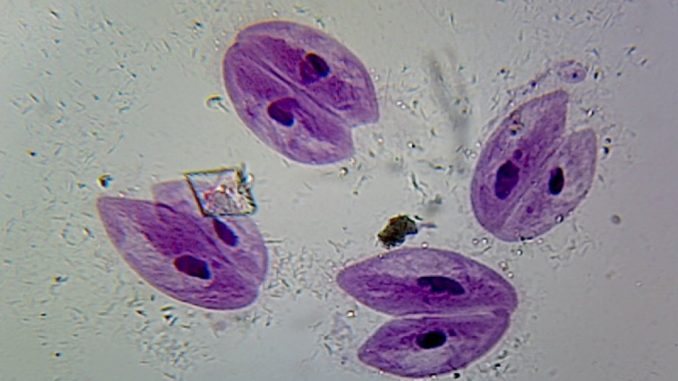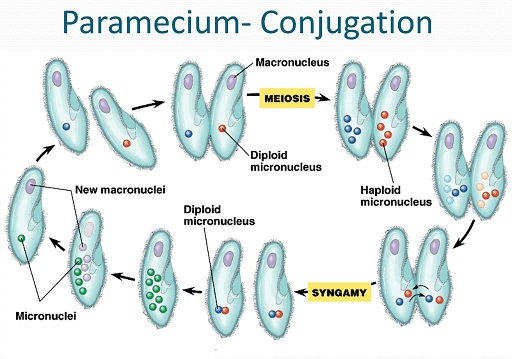
Asexual reproduction:
- Paramecium reproduces asexually by transverse binary fission and is found during favorable conditions.
- Binary fission in Paramecium completes in the following steps:
- Paramecium stops feeding.
- Oral groove disappears.
- The micronucleus becomes spindle shaped and divides mitotically and forms two daughter micronuclei.
- The macronucleus changes its shape and through a slit it divides amitotically into two.
- The endoplasm is divided into two in the middle of the cell transversely.
- The anterior portion is known as proter and the posterior portion is known as opishte.
- The proter and opisthe portions are just like that of their parents in size, shape and structure.
- The whole process completes within twenty minutes and in 24 hours it divides two or three times.
- All such individuals which are formed from a single parent is known as clone.
Sexual reproduction:
- This type of reproduction is done through conjugation.
- Conjugation is temporary union between two individuals during which exchange of genetic material takes place.
- It occurs during unfavorable condition and completes in the following steps:
- Paramecium stops its movement and feeding.
- Two Parameca meet in the portion of their oral grooves and the pellicle and ectoplasm degenerates.
- A new endoplasmic bridge is formed between their buccal apparatus.
- These two united Paramecia are known as conjugants.
- The macronucleus disintegrates and the micronucleus increases in size and divided mitotically into two parts.
- The nucleus of each Paramecium divides again and forms four haploid nuclei.
- Out of the four haploid nuclei, three disappear and one persists.
- From this single nucleus two nuclei are formed mitotically and distributed into two portions. One is known as stationary or female pro-nucleus and the other is known as migratory nucleus or male pro-nucleus.
- The male pro-nucleus passes into another Paramecium through the endoplasmic bridge and fuses with the female pro-nucleus.
- Two synkaryons (a cell nucleus formed by the fusion of two pre-existing nuclei) are formed in each Paramecium. They are diploid in nature just like that of their parent cells.
- In this way, the heredity materials of both of the Paramecia are transferred to each other.
- After the above changes the two Paramecia are separated known as ex-conjugants.
- The synkaryon of ex-conjugants divides three times repeatedly and produces eight nuclei. Among them the big four are called macronuclei and the small four are called micronuclei. Out of four micronuclei, three disappear.
- Later one micronucleus which was left divides into two. So in each dividend Paramecium one micro and two macronuclei are present.
- The micronuclei of two daughter Paramecia divides into two and later the daughter Paramecium also divides mitotically into two.
- In this way, eight Paramecia are formed after conjugation of conjugants.
Importance of conjugation:
- After continuous binary fissions the micronucleus of Paramecium becomes very weak. So conjugation helps in the rejuvenation of it.
- The mutual transfer of hereditary materials brings the new daughter nuclei, new vigor and vitality.
- Due to the repeated divisions, the macronucleus also becomes very weak. So by this process it is also rejuvenated, and this helps to store energy and strength in Paramecium.

